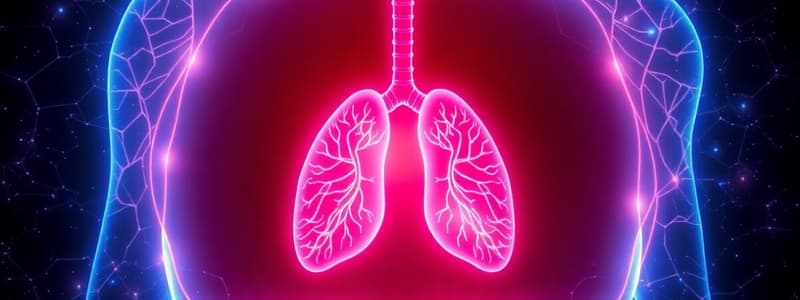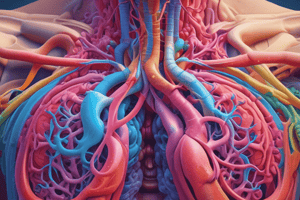Podcast
Questions and Answers
What process allows oxygen to move from the blood into cells?
What process allows oxygen to move from the blood into cells?
- Active transport
- Filtration
- Diffusion (correct)
- Osmosis
What is a normal range for arterial blood pO2 levels?
What is a normal range for arterial blood pO2 levels?
- 75-100 mmHg (correct)
- 100-120 mmHg
- 60-80 mmHg
- 35-45 mmHg
Where are the central chemoreceptors located?
Where are the central chemoreceptors located?
- Lungs
- Carotid arteries
- Medulla of the brainstem (correct)
- Aortic bodies
What condition is characterized by slow and shallow breathing, leading to insufficient CO2 removal?
What condition is characterized by slow and shallow breathing, leading to insufficient CO2 removal?
What triggers the peripheral chemoreceptors to signal the brain to increase breathing rate?
What triggers the peripheral chemoreceptors to signal the brain to increase breathing rate?
What occurs when carbon dioxide levels rise in the body?
What occurs when carbon dioxide levels rise in the body?
Which of the following values indicates a normal range for pCO2 levels?
Which of the following values indicates a normal range for pCO2 levels?
What defines hyperventilation?
What defines hyperventilation?
What happens to the diaphragm during exhalation?
What happens to the diaphragm during exhalation?
Which gas is primarily delivered to cells from the blood in tissues?
Which gas is primarily delivered to cells from the blood in tissues?
What role does hemoglobin play in the respiratory system?
What role does hemoglobin play in the respiratory system?
What is the purpose of chemoreceptors in the respiratory system?
What is the purpose of chemoreceptors in the respiratory system?
What occurs during gas exchange in the lungs?
What occurs during gas exchange in the lungs?
What effect does increased carbon dioxide have on blood pH?
What effect does increased carbon dioxide have on blood pH?
What is indicated by a high level of oxygen in arterial blood?
What is indicated by a high level of oxygen in arterial blood?
What is the primary function of alveoli in the lungs?
What is the primary function of alveoli in the lungs?
What is the primary role of hemoglobin in the respiratory system?
What is the primary role of hemoglobin in the respiratory system?
During the gas exchange process, what is primarily exchanged for oxygen in the alveoli?
During the gas exchange process, what is primarily exchanged for oxygen in the alveoli?
How do chemoreceptors affect respiratory function?
How do chemoreceptors affect respiratory function?
What could be a consequence of hypoventilation on blood gas values?
What could be a consequence of hypoventilation on blood gas values?
Which of the following is NOT a typical effect of aging on respiratory function?
Which of the following is NOT a typical effect of aging on respiratory function?
What could be the impact of a diet rich in antioxidants on respiratory health?
What could be the impact of a diet rich in antioxidants on respiratory health?
Regular exercise contributes to the respiratory system by:
Regular exercise contributes to the respiratory system by:
Which breathing pattern indicates tachypnea?
Which breathing pattern indicates tachypnea?
Flashcards
Blood gas values interpretation
Blood gas values interpretation
Blood gas tests (like pO2 and pCO2) assess lung gas exchange. Normal pO2 (75-100 mmHg) shows healthy oxygen levels, and normal pCO2 (35-45 mmHg) indicates normal carbon dioxide levels. Abnormal values suggest breathing or metabolic problems.
pH regulation
pH regulation
The body maintains blood pH (7.35-7.45) using the bicarbonate buffer system. Increased CO2 leads to lower pH (more acidic), and breathing helps remove CO2. Kidneys adjust bicarbonate levels too.
Central chemoreceptors
Central chemoreceptors
Located in the medulla, these receptors sense changes in carbon dioxide levels by monitoring cerebrospinal fluid pH. Increased CO2 triggers a faster breathing rate.
Peripheral chemoreceptors
Peripheral chemoreceptors
Signup and view all the flashcards
Hyperventilation
Hyperventilation
Signup and view all the flashcards
Hypoventilation
Hypoventilation
Signup and view all the flashcards
Normal Breathing Pattern
Normal Breathing Pattern
Signup and view all the flashcards
Cellular diffusion
Cellular diffusion
Signup and view all the flashcards
Respiration, definition
Respiration, definition
Signup and view all the flashcards
Glycolysis, respiration stage 1
Glycolysis, respiration stage 1
Signup and view all the flashcards
Krebs Cycle, respiration stage 2
Krebs Cycle, respiration stage 2
Signup and view all the flashcards
Oxidative Phosphorylation, respiration stage 3
Oxidative Phosphorylation, respiration stage 3
Signup and view all the flashcards
Inhalation mechanism
Inhalation mechanism
Signup and view all the flashcards
Exhalation mechanism
Exhalation mechanism
Signup and view all the flashcards
Gas exchange (lungs)
Gas exchange (lungs)
Signup and view all the flashcards
Hemoglobin function
Hemoglobin function
Signup and view all the flashcards
Altered Breathing
Altered Breathing
Signup and view all the flashcards
Hypoxia
Hypoxia
Signup and view all the flashcards
Hypercapnia
Hypercapnia
Signup and view all the flashcards
Respiratory System's Role
Respiratory System's Role
Signup and view all the flashcards
Aging Effects on Respiration
Aging Effects on Respiration
Signup and view all the flashcards
Lifestyle Choices and Respiratory Health
Lifestyle Choices and Respiratory Health
Signup and view all the flashcards
Study Notes
Respiratory System
- Common Terms:
- Pulmo- lungs
- Hyper- above, excessive
- Dys- difficult, painful
- Alveol/o- Alveolus
- Bronch/o - Bronchus
- Diaphragm/o- Diaphragm
- Hem/o - Blood
- Lobe/o - Lobe
- Ox/i- Oxygen
- Nas/o - Nose
- Capn/o - Carbon dioxide
- Orth/o- Straight
Respiration Definition
- Respiration is a metabolic process where cells obtain energy (ATP) by using oxygen and releasing carbon dioxide from the oxidation of organic substances.
Stages of Respiration
-
Stage 1: Glycolysis
- Eight enzymes break glucose into two 3-carbon molecules.
- Releases energy to create temporary energy stores (ATP and NADH) for later ATP building.
-
Stage 2: The Krebs Cycle
- Considered the most crucial stage of respiration.
- Drives the formation of crucial electron carriers (important for later ATP production).
- Important for carrying energy for ATP creation.
-
Stage 3: Oxidative Phosphorylation
- Electrons from NADH and FADH2 move through the electron transport chain (in mitochondria).
- Generates a proton gradient used to produce ATP.
Pulmonary Ventilation
-
Inhalation:
- Diaphragm contracts and moves down
- Intercostal muscles move rib cage up
- Air pressure decreases to allow more air in the lungs.
-
Exhalation:
- Diaphragm rises and expands
- Intercostal muscles move rib cage down
- Air pressure increases so air is forced out of the lungs.
Gas Exchange
-
Lungs: Oxygen enters the blood, and carbon dioxide is removed.
-
Tissues: Oxygen is delivered to cells and carbon dioxide is picked up for transport back to the lungs. Hemoglobin plays a crucial role in carrying oxygen and carbon dioxide in the blood.
Cellular Diffusion
- Oxygen moves from blood (high concentration) to cells (low concentration).
- Carbon dioxide moves from cells (high concentration) to blood (low concentration).
- This happens across capillary walls by simple diffusion.
Blood Gases
- PO2: Normal range is 75-100 mmHg (indicates healthy oxygen levels).
- PCO2: Normal range is 35-45 mmHg (indicates healthy carbon dioxide levels).
- Abnormal levels indicate potential breathing or metabolic problems.
Regulation of pH
- The body maintains blood pH between 7.35 and 7.45 using the bicarbonate buffer system.
- Breathing and kidneys help adjust bicarbonate levels to balance pH when CO2 levels rise or fall.
Chemoreceptors
- Central: Located in the medulla of the brain, detect changes in CO2 levels (by monitoring cerebrospinal fluid pH).
- Peripheral: Located in the carotid and aortic bodies, detect oxygen levels in the blood and signal the brain to adjust breathing if needed.
Hyperventilation/Hypoventilation
- Hyperventilation: Rapid and deep breathing, leading to excessive CO2 expulsion (respiratory alkalosis).
- Hypoventilation: Slow and shallow breathing, leading to insufficient CO2 removal (respiratory acidosis).
Breathing Patterns
- Normal: Quiet, regular breathing (12-20 breaths/minute in adults).
Altered Breathing
- Tachypnea: Rapid breathing
- Bradypnea: Slow breathing
- Dyspnea: Shortness of breath
- Hyperventilation: Deep, rapid breathing
- Hypoventilation: Shallow, slow breathing
Respiratory System Wellness
- Oxygen supply and CO2 removal are crucial for energy production and maintaining body pH balance.
- Respiratory system health is vital for optimal overall organ function and vitality.
Aging and the Respiratory System
- Lung elasticity decreases with age.
- Breathing muscles weaken.
- Reduced number of alveoli, affecting gas exchange efficiency.
Lifestyle Choices
- Smoking and pollution damage the lungs, increasing respiratory disease risks.
- Exercise strengthens respiratory system, improving lung function and oxygen exchange.
Nutrition and Respiration
- A healthy diet with fruits and vegetables provides antioxidants to protect the lungs.
Diagnosing and Treating Conditions
- Various conditions (asthma, chronic obstructive pulmonary disease, pneumonia, and tuberculosis) are diagnosed and treated using methods like medical history, physical exams, imaging tests, and specific treatments (medications, lifestyle changes, etc.).
Respiratory System Impact on Other Systems
- Respiratory pathologies can affect the cardiovascular system by straining the heart, decreasing oxygen supply and leading to fatigue, and other complications.
Community Resources
- Support groups and healthcare services (including respiratory therapy) help manage and improve quality of life for individuals with respiratory conditions.
Studying That Suits You
Use AI to generate personalized quizzes and flashcards to suit your learning preferences.




